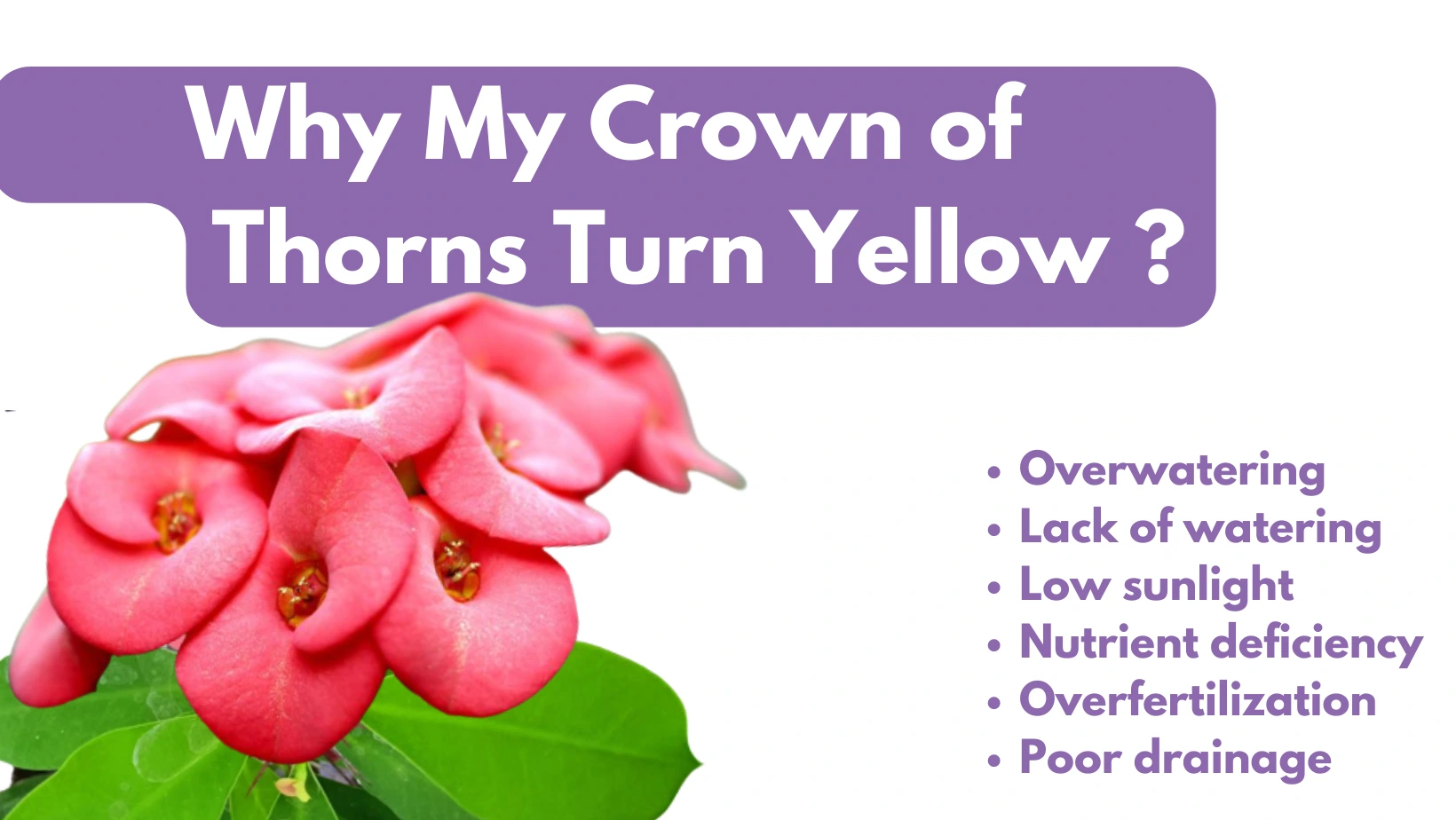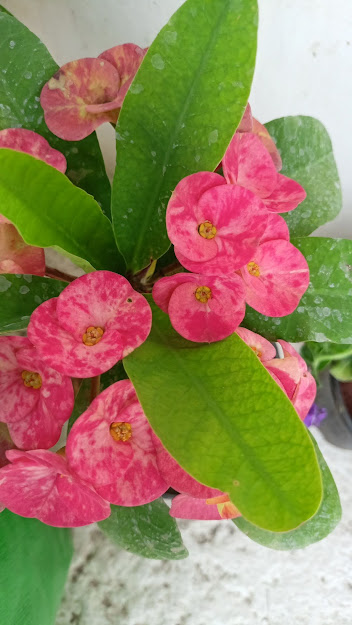Crown of thorns is a perennial flowering species of spurge Euphorbiaceae family. This beautiful plant has many other names besides crown of thorns; such as Christ plant, Euphorbia milii, Christ thorn, etc.
Note: Crown of thorns is not a cactus, native to Madagascar it is a succulent
It can grow up to 6 ft tall while cultivated outdoor and can grow up to 2 ft. tall in an indoor planter circumstance. You don’t need to care extra care to get the best form of a growing crown of thorn plant in your garden.
Fulfill only a few basic growing requirements and witness the most thriving form of this flowering succulent delightfully. Here are some imperative statistics in this attempt-
How to Care Crown of Thorns:
Soil: Use cactus mix potting soil that combines with sand or perlite. Make sure the soil can drain well and has a pH balance between neutral to slightly acidic.
Water: It has low to moderate water needs. So, wait till the top surface of the planting soil turns 60-70% dry. Water only 1-inch per week with a watering can or a large sprayer.
Fertilizer: feed your succulent once a week and spring through fall consistently. Apply any commercial houseplant fertilizer in diluted half of strength form and a 10-10-10 NPK ratio.
Sun Exposure: It can tolerate total sun exposure to the sun with partial shade, depending on its growing condition. You can place the planter in either west or a south-facing window to provide the best light source.
Climate: Keep the temperature between 65 to 75° F through the entire growing session, especially during the blooming period. It can thrive in medium to high humidity brilliantly
Pruning: Crown of thorn is a slow grower, and thus, you don’t need to prune your plant much. Just remove the old or discolored foliage attentively every 3-4 months. A proper session every 1-2 years is enough to maintain this plant vigorously.
Repotting: Try to repot your crown of thorn plant every 2 years into a 2-3 inches bigger planter. DO this course during late winter or early spring, and don’t forget to water your plant thoroughly after the replantation.
Pests and Diseases – Troubleshoots: Scales, thrips, mealybugs, spider mites, etc. are some common insects you may find around a growing crown of thorn succulent. Treat them with neem oil or soapy water to get quick yet harmless effects on your infected plants.
How to Propagate Crown of Thorns:
It is a hybrid species and thus, quite difficult to grow from seeds. This crown of thorn succulent mostly regrows from their tip cuttings. Let’s learn how to do the process perfectly in this step-by-step method-
Things needed:
- A disinfected shear or pruner
- Some paper towels
- Rooting hormone
- A clay planter
- Cactus mix
- Normal potting soil
- And a watering can with some fresh distilled water
How to:
- Find a freshly grown stem on the parent plant and cut it off about 4-5 inches with a cutter
- Cut exactly below the node and be certain that your cutting has 5-6 leaves on it
- Remove the leaves from its bottom and leave only 2-3 leaves on the top
- Place it on a layer of paper towel for 1-2 days and let the wound heal properly
- Now, dip the callused end into the rooting hormone container before sowing
- Finally, bring a planter filled with preferred potting mix and plant the cutting into it
- Secure the base well by patting the soil tightly and watering it thoroughly
- Place the planter in a warm and moderately humid place in your room
- Make sure that your cutting could have bright but indirect sunlight till the rooting
- New shoots will come out within 12 to 14 weeks, then just provide your plant with its needed supplies to thrive accurately.
Why are the Leaves of My Crown of Thorns Plant Turning Yellow?
Crown of thorns grows bright flowers in vibrant shades including red, pink, yellow, and sometimes white too. These blossoms display more excitement while blooming around thick green foliage.
The deep green leathery leaves of this succulent are another attraction point of the beauty of the crown of thorns plant.
Sometimes, the stunning appearance of this plant gets hampered due to the discoloration of foliage. Sometimes, you may find that the leaves of your growing crown of thorns plant suddenly turn yellow or pale green.
This could be happened due to improper caring methods. Here are some clear notes about this issue along with some possible solutions as well-
Causes:
- Overwatering
- Lack of watering
- Low sunlight
- Nutrient deficiency due to improper fertilization
- Overfertilization
- Poor drainage
- And unsuitable growing condition
Solutions:
- Water your plant every week about 1-1.5 inches in depth
- Never let your plant unwater for more than 14-15 days
- Place the plant where it can grab at least 6-8 hours of bright sunlight regularly
- Direct sun exposure is not essential for the crown of thorns, just make sure it can get bright light adequately
- Feed your plant steadily, especially during spring and fall with a suitable fertilizer
- And apply a high-phosphorous fertilizer once a year during the blooming season for a better blooming experience
- Do not fertilize during the winter season
- Make sure the planter and the soil can drain the excess water well
- Finally, don’t place the planter while it can’t get enough light, temperature, or humidity. To keep the foliage as well as the entire plant healthy, you must maintain a healthy circumstance around your plant that prefer a growing crown of thorns perfectly.
How to Often Crown of Thorns Bloom:
If you can provide proper care to a crown of thorns plant, it can bloom almost 4 back to back seasons in a year. These are successively spring, summer, fall, and winter.
Try to be regular and steady in the fertilization schedule to keep the blooming quality of your plant uninterrupted. You can apply a high-phosphorous fertilizer once to twice a year to boost the blooming capacity of your crown of thorns plant more efficiently.
FAQ:
Is Crown of Thorns Plant Poisonous?
Unfortunately, this crown of thorns succulent is highly toxic and considered poisonous for humans as well as any other mammals, including house pets. This plant is native to the wild regions of Africa and contains venomous properties, like any other wild flowering species.
Is Crown of Thorns Toxic:
The milky white sap, similar to latex is highly toxic to human bodies, besides, the phorbol easter is another high poisonous component, found inside the crown of thorns body. These properties provide dangerous reactions and sometimes even turn fatal when getting direct contact with the stomach of a living being!
What Could Be The Reactions:
- Excessive salivation
- Oral irritation
- Diarrhea
- Vomiting
- Blood in vomit
- Abdominal pain
- Weakness
- Dizziness
- Swelling and blistering eyes
- Skin irritation
- Gastrointestinal issues
- And upset stomach
How to Deal with This:
If any of your house pets or your kid or any adult take a bite on this succulent or gulp it unknowingly, try to take these initiatives immediately-
- Remove the trace of that latex instantly
- Wash the mouth of the eater right away
- Encourage the person of the pet to vomit
- Let the swallower gulp some activated charcoal immediately
- Try to let the mouth of an eater wash with milk or mild soap
- Provide flush of water to the eyes, in the case of blistering eyes
- Take the suffer to the nearest medical center immediately
- And go for the intestinal lining, if the person or the pet ingests any part of the sap entirely
So, this is how you can get rid of the poisonous grasp of a crown of thorns plant smartly. However, it will be better if you keep the plant away from the reach of your kids or house pets attentively. This can save you from happening such mishaps in the near future again.



